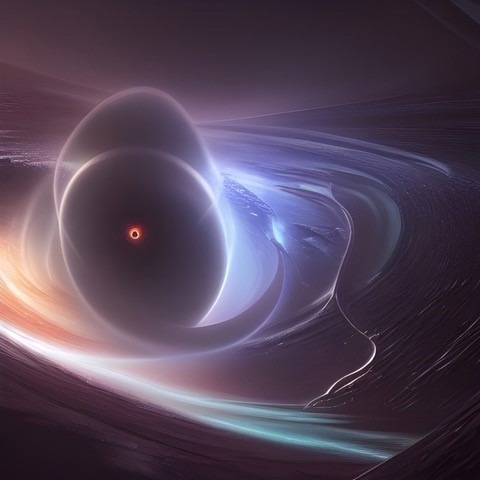University of Queensland researchers have proven black holes’ bizarre quantum properties, such as their mind-boggling capability to hold many masses in one go.

Mass-quantised black hole—recreated using NightCafe Creator AI. Image Credit: The University of Queensland.
A group of theoretical physicists spearheaded by Ph.D. candidate Joshua Foo at UQ undertook calculations that revealed unexpected black hole quantum events.
Black holes are an incredibly unique and fascinating feature of our universe. They’re created when gravity squeezes a vast amount of matter incredibly densely into a tiny space, creating so much gravitational pull that even light cannot escape. It’s a phenomenon that can be triggered by a dying star.
Joshua Foo, Ph.D. Candidate, The University of Queensland
Mr. Foo continues, “But, until now, we haven’t deeply investigated whether black holes display some of the weird and wonderful behaviors of quantum physics. One such behavior is superposition, where particles on a quantum scale can exist in multiple states at the same time. This is most commonly illustrated by Schrödinger’s cat, which can be both dead and alive simultaneously.”
But, for black holes, we wanted to see whether they could have wildly different masses at the same time, and it turns out they do. Imagine you’re both broad and tall, as well as short and skinny at the same time—it’s a situation which is intuitively confusing since we’re anchored in the world of traditional physics. But this is reality for quantum black holes.
Joshua Foo, Ph.D. Candidate, The University of Queensland
To demonstrate this, the researchers created a mathematical framework that allows them to “place” a particle outside of a theoretical mass-superposed black hole.
Mass was specifically examined because it is a distinguishing feature of a black hole, and it is possible that quantum black holes would naturally have mass superposition.
Dr. Magdalena Zych, a research co-supervisor, stated that the findings support earlier quantum physics concepts.
Our work shows that the very early theories of Jacob Bekenstein—an American and Israeli theoretical physicist who made fundamental contributions to the foundation of black hole thermodynamics—were on the money.
Dr Magdalena Zych, Research Co-Supervisor, The University of Queensland
Dr. Magdalena Zych adds, “He postulated that black holes can only have masses that are of certain values, that is, they must fall within certain bands or ratios—this is how energy levels of an atom works, for example. Our modeling showed that these superposed masses were, in fact, in certain determined bands or ratios—as predicted by Bekenstein.”
“We didn’t assume any such pattern going in, so the fact we found this evidence was quite surprising. The universe is revealing to us that it’s always more strange, mysterious and fascinating than most of us could have ever imagined,” concludes Dr. Zych.
Journal Reference
Foo, J., et al. (2022) Quantum Signatures of Black Hole Mass Superpositions. Physical Review Letters. doi.org/10.1103/PhysRevLett.129.181301.